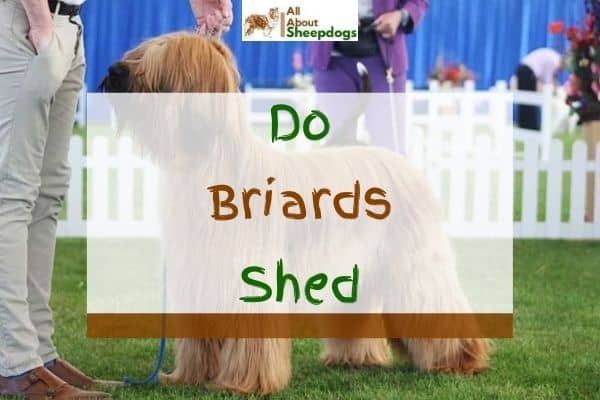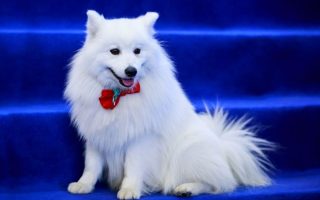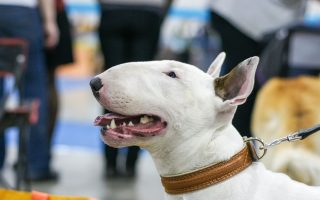Lately, Briards have surged to the top of the list of the most popular family dogs. Their popularity is understandable as they’re a loving, intelligent, and loyal breed.
Also, a big part of the appeal is their rugged good looks.
With their scruffy appearance emphasized by the long shaggy fur, they’re certainly among the most adorable breeds and real head-turners.
However, a long and furry coat often means much more work for the owners, so, one of the first things that interest potential owners is do Briards shed?
This is particularly important for those who live in apartments or plan to keep the dog inside.
With some breeds, cleaning after them and grooming them can turn into almost a full-time job.
Below, you’ll learn if Briards belong to that group and find out all you need to know about Briards when it comes to their coats, shedding, and grooming needs.
So, read on to learn more!
[wpsm_toplist]
Do Briards Shed?
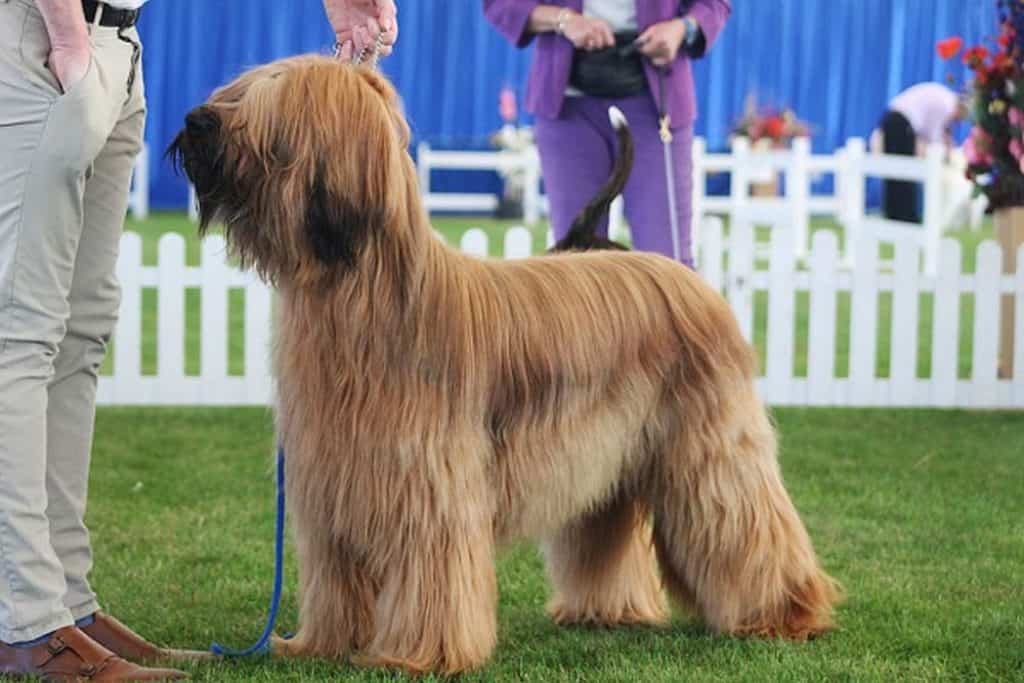
Despite the fact that their bodies are covered with long and fluffy fur, Briards are not known as a breed that sheds too much.
Like most dogs, Briards do shed, but not excessively and we can count them into low to moderate shedding breeds.
This means that with regular grooming, you should be able to keep your house relatively clean and free of hair.
Unlike some other breeds, such as Labrador or German Shepherd, Briards don’t shed all their hair at once nor do they have a particular season when they shed.
Their shedding is less obvious and takes place throughout the year.
Most of the shedding comes from the soft undercoat, while the topcoat is less, or not at all, inclined to shed.
However, the undercoat will shed periodically and often get matted and tangled with the longer hair of the topcoat creating knots that fall to the ground.
What Kind Of Coat Does A Briard Have?
One of the Briard’s distinctive features, and one they’re most recognizable for, is the abundant double coat.
The coat covers the entire body, even the eyes and ears which are quickly overgrown by hair.
Briards can feature numerous color variations, but commonly their coat is black, tawny, or gray, or the combination of those colors.
The hair is relatively smooth and forms undulant locks as it falls over the body. The coat has a natural parting on the head, neck, and along the back.
Topcoat and Undercoat
The topcoat is longer than the undercoat. With adult dogs, the hair length is usually about 6 or more inches at the shoulder.
The outer coat is slightly wavy and has a coarse and hard texture.
It grows slower than the undercoat, and when cut or pulled out, can take a long time to grow back.
The undercoat is much softer and commonly 3-5 inches long.
Grooming
It may sometimes cause grooming issues as dogs can occasionally develop a very heavy undercoat, overwhelming the general appearance.
This is why regular grooming and combing are essential when owning a Briard.
New owners should be aware that leaves, snow, or mud will often cling to Briard’s long fur and if not cleaned. leave a mess around the house.
The long beard will also absorb water and pieces of food.
How Do You Deshed A Briard?
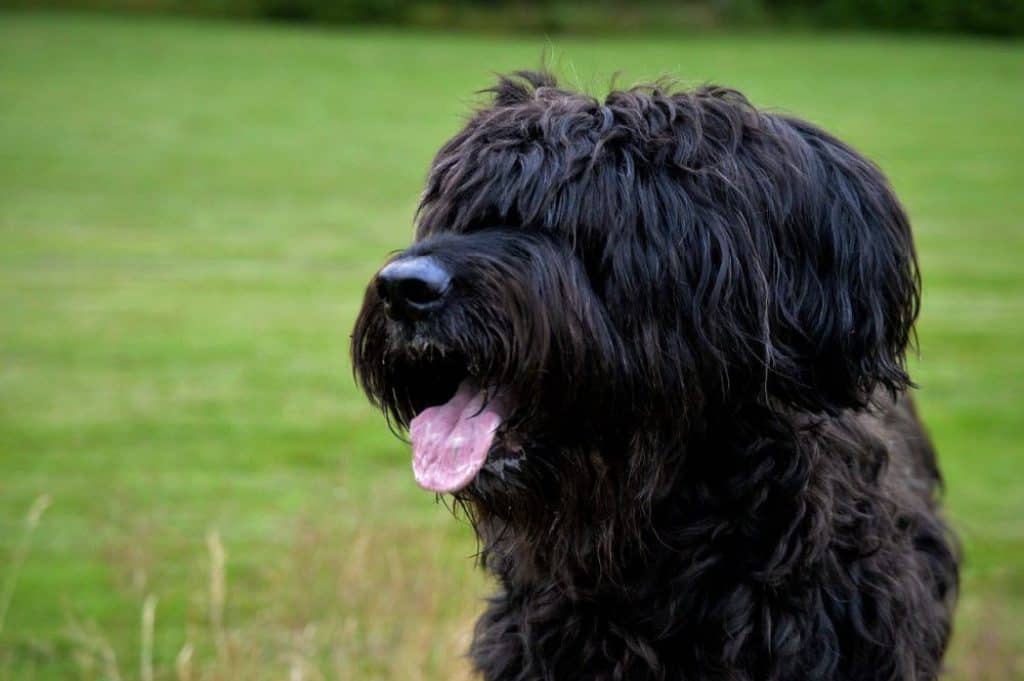
Deshedding your Briard will help to remove the loose undercoat. This is done to ensure the old hair doesn’t land on your couch or table.
It also draws out the natural oils from the dog, making it comfortable. Plus, the dog will be happier without clumps of hair as it walks around the house.
This practice stops too much hair from shedding but won’t stop the process. When done regularly, the effect will be noticeable.
How much the dog will shed is determined by the body size and fur’s length.
Since there are many methods of Deshedding, you should choose one that suits you best.
[amazon box=”B00ZGPI3OY”]
First, you should bathe the dog and brush the hair until no more comes out. Repeat the process every 8 weeks.
If you’re short on time, you can use a leave-in conditioner for a smooth de-shedding session.
Since briards have a double coat, you should use a slicker dog brush or an undercoat rake. They work on the undercoat while leaving the topcoat untouched.
[amazon link=” B00ZGPI3OY ” title=”A slicker brush” link_icon=”amazon” /] is also effective at removing the tangles.
[amazon box=”B07575941G”]
Another common method is using a bristle brush.
Be sure to invest in one that won’t hurt your dog’s undercoat but one that can help with detangling.
If you’re using [amazon link=” B07575941G ” title=”a bristle brush” link_icon=”amazon” /], you should shampoo the dog’s hair and brush front to back.
Repeat the process every eight weeks.
[amazon box=”B01FE3IIC4″]
Puppies will have short hair, so you can use [amazon link=” B01FE3IIC4 ” title=”a rubber brush” link_icon=”amazon” /].
Just like bristle brushes, de-shedding will stimulate circulation on the skin and minimize the amount of hair.
You should follow the same routine as the one stated above.
When you brush your dog, you should go against the grain – from head to tail.
If the hair is too wavy, you can wet the brush slightly. Similarly, if the hair is too thick, you can use a comb in addition to a brush.
[amazon box=”B07ZNR71W9″]
If your dog has medium hair, you can use [amazon link=” B07ZNR71W9 ” title=”a de-shedding blade” link_icon=”amazon” /]. This tool ensures there’s little damage to your dog, but you have to try it out.
The only challenge with this method is that it can pull on tangles.
If you want to get the best results, you should shampoo and condition the hair. Depending on the size of a dog, deshedding can take up to two hours.
When you deshed a double coat, the general guidelines to follow are:
- Remove dead hairs from the undercoat – use a rooming rake
- Since the fur is thicker on the neck and ears, use a thicker brush
- Brush the dog a couple of times a month
- Use a wide comb to work through the tangles. If you have to cut, you should pinch the fur as possible.
- Use a bristle brush to give your briard a shine.
Are Briards Hypoallergenic?
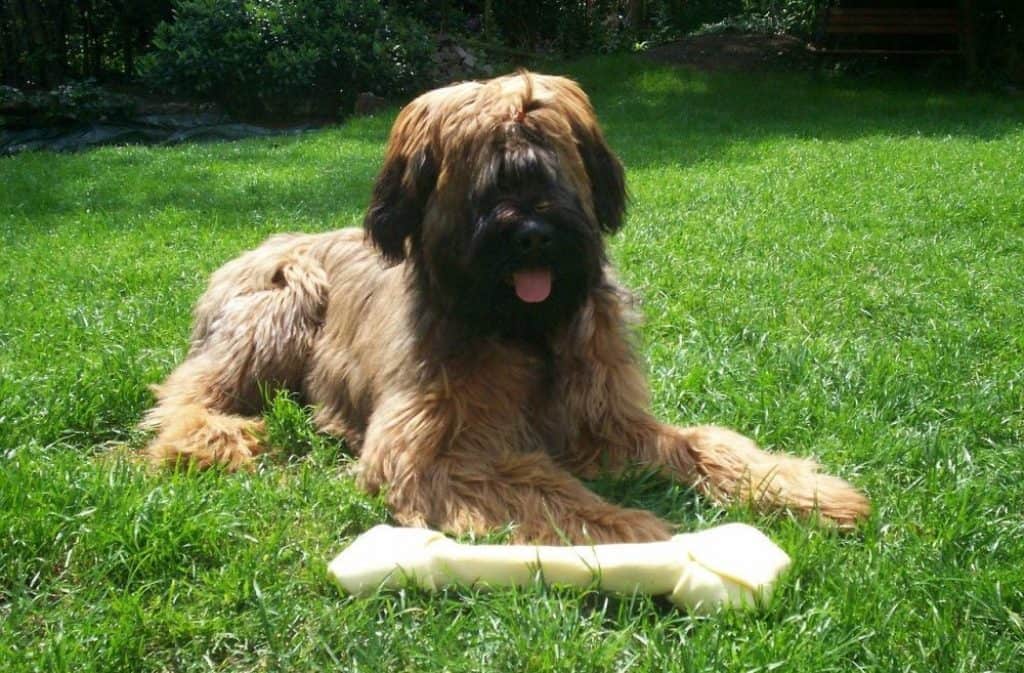
Briards are hypoallergenic (allergy-friendly). They produce less dander, so allergy sufferers will be comfortable.
And that’s why it’s a great choice for people with allergies. If you love your furry friend, your allergies don’t have to ruin your relationship.
But here is the thing – it doesn’t mean that your briard won’t cause an allergic reaction in your household.
Instead, the allergies will be less severe as compared to other breeds.
From a scientific standpoint, you may think that allergies are caused by your dog’s hair or fur, but by dander itself.
And it’s only found on the coat or skin. This explains why experts recommend dogs with a double coat like briards.
Also, briards have fur that is similar to human skin, so it won’t make you sneeze. They require regular brushing and maintenance to ensure they stay tangle-free.
How To Live With A Briard And Allergies?
Did you know that you can still enjoy a wonderful time with your furry friend even if you have allergies?
Some people believe that once they are diagnosed with an allergy, they have to get rid of their pets.
Here are a few tricks for living with a briard if you have allergies.
Understand Your Pet Allergies
You must get tested to establish the kind of allergic reaction you have. You may think that you’re allergic to your dog only to realize it’s something else.
But if the results show that you’re allergic to dogs, the allergist will determine the causes.
According to experts, there are allergy-triggering proteins that cling to the animal’s fur. Sometimes, it can stick on the carpets, clothing, or walls.
The allergist will then examine the reactions. And the reaction may range from sneezing to life-threatening asthma.
The reaction can be worse if you’re exposed to dust mites, pollen, mold, cigarette smoke, etc.
Your doctor can even recommend the types of medications to take to minimize exposure to allergens.
For instance, over-the-counter antihistamines work well on those troublesome days.
Create A Regular Grooming Routine
Nothing can bring down the allergens in your dog than regular grooming. When brushing, you should wear a mask.
After that, use a moist towel to prevent the bits of dander from flying – a furminator can be a good choice.
You can also use microfiber towels to wipe the pollen off your dog.
Clean Your Home With Allergy Sprays
Even if you can’t afford it, hiring a crew to do the heavy lifting can help a lot. The team will clean behind the furniture and all those pet hairs in hard-to-reach areas.
For routine cleaning, use sprays, and a robotic cleaner.
The only challenge you’ll have is to clean the filters. The wet-style cleaning is a safer approach to traditional sweeping.
Don’t Touch Other Dogs
Now that you’re groomed your dog, you should avoid touching other dogs.
This could trigger allergy symptoms.
And you never know – others may not be cleaning their pet regularly as you do.
Reduce The Allergy Symptoms
If you’re allergic to your pet, there are many things you can do to reduce the symptoms.
If the symptoms are not life-threatening, you can use HEPA air cleaners to dust the blinds, curtains, and floors.
You should also wash the pillows, couch covers, and pet beds. Next, set up an allergy-free zone.
For instance, you should make sure the pet doesn’t enter the allergic person’s bedroom.
When you let the dog on the bed, some allergens can transfer to the blankets.
Another strategy to remove the allergens is using impermeable covers for pillows and mattresses.
You must work with an allergist who understands your commitment to your dog. When you follow the above tips, you’ll be glad you dint let the allergies break you up.
Final Thoughts
From the above post, I have answered the question – do briards shed?
Briards shed less compared to other dog breeds and have no phrase in shedding. They have lots of hair on the upper body that can get tangled without proper care.
When brushing the dog, you should do it gently to massage the skin and nourish the roots.
If you realize your canine friend is shedding a lot, then that could be a sign of an underlying problem.
You can take care of the excessive shedding by combing regularly and following the above grooming tips.
It’s time you maintain a happy briard just like you would with any other pet in your home.

